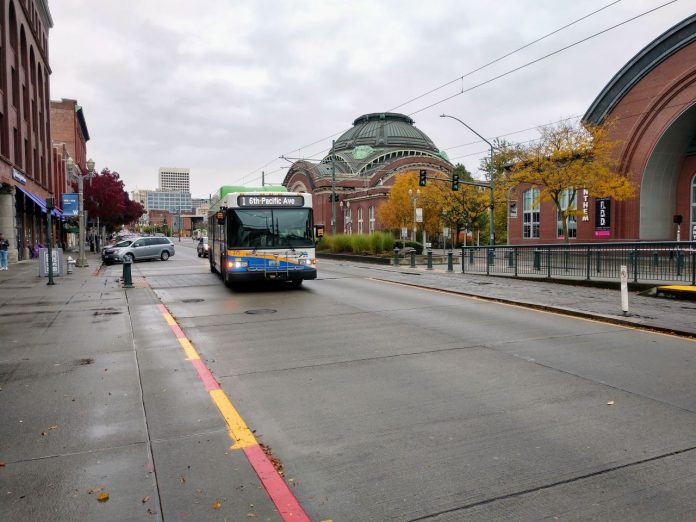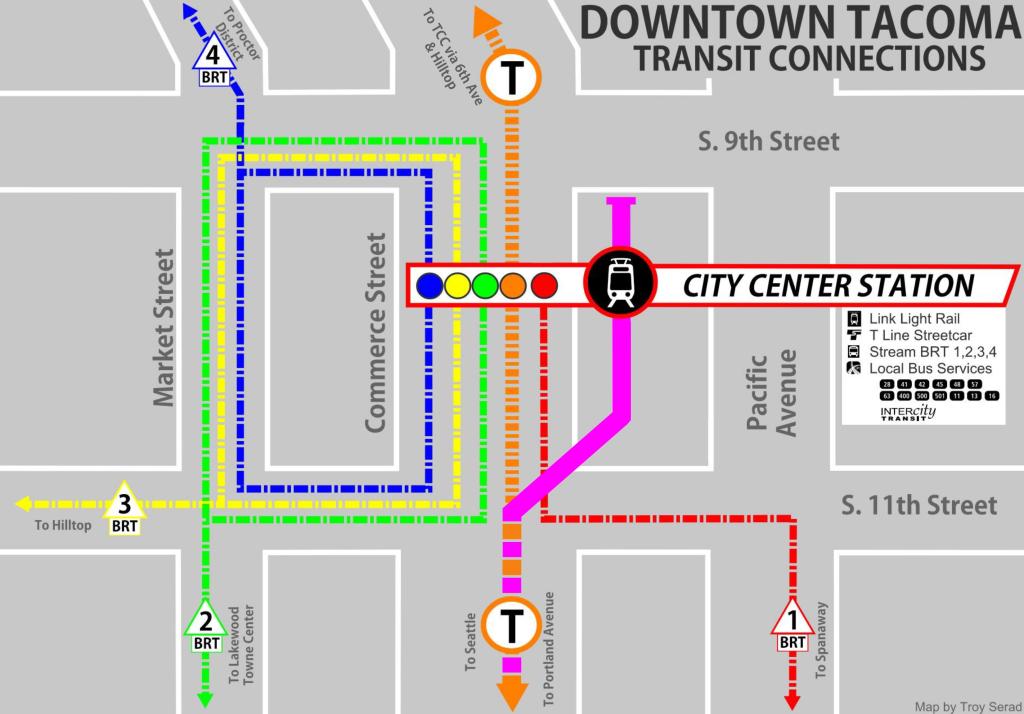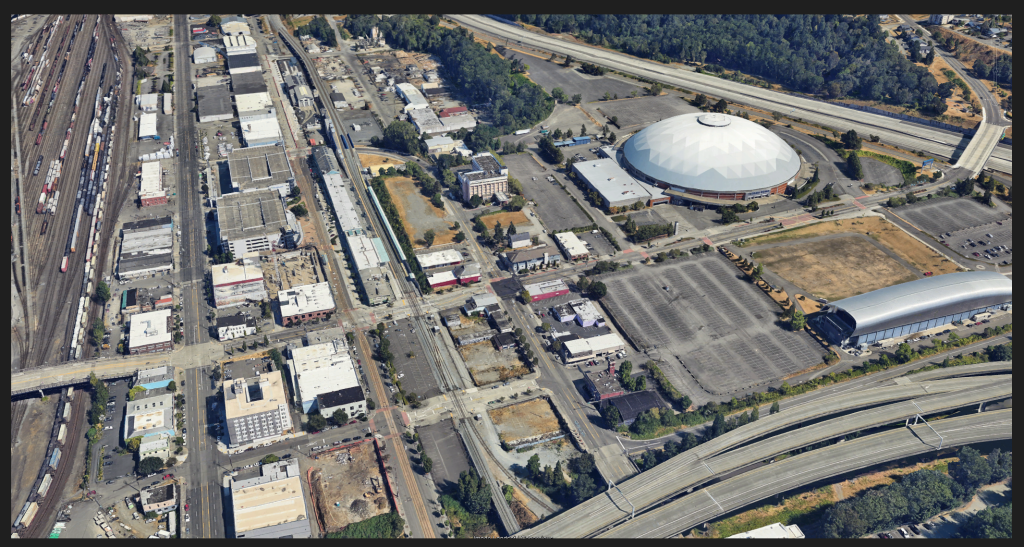
Sound Transit built the last two miles of Pierce County’s Link light rail spine decades ago in the downtown core of Tacoma. The rail line along Commerce Street, Pacific Avenue and 25th Street exists as the southern Link terminus of, and starter line to, a growing regional network that Pierce County voters envisioned and approved in 1996. It’s called Tacoma Link.
That vision eroded over years of isolation from the regional light rail network and its separate T Line operation. Subsequent long range plan revisions and transit expansion packages erroneously redirected the Link light rail spine terminus to the Tacoma Mall by way of Tacoma Dome, bypassing the urban core of Pierce County. Downtown Tacoma has been ready for decades for integration, and its planned bypass is already resulting in negative transportation and development outcomes.
Purposeful leadership can rectify the issue. As King County readies for an East Link starter line, Pierce County should direct Sound Transit to finish theirs. With upgrades that Sound Transit once proposed and had even approved for funding, along with key additions to modernize their plan, the existing railway can host both regional trains and local T Line services. The subarea transit network would be greatly strengthened.
This article will explain how this integration could occur, to be delivered after the opening of the Tacoma Dome Link Extension in 2035.

THE CRUMBLING TACOMA LINK VISION
The vision of Tacoma Link traces back to 1987 with a proposed light rail terminus near Old City Hall. By 1991, the concept of light rail terminating in Downtown Tacoma was drafted into Metro Transit’s plans as a result of strong local leadership. This includes State Representative Ruth Fisher, who was instrumental in establishing the Central Puget Sound Regional Transit Authority, or RTA.
Downtown Tacoma was a terminus of the RTA’s $6.7 billion light rail proposal in 1995. Voters rejected it due to cost and lengthy timelines. In response, the agency proposed a new incrementalist plan called Sound Move featuring two shorter lines: Central Link out of Seattle, and Tacoma Link out of Tacoma. The package passed in 1996 and Sound Transit was born.
Tacoma Link is a 1.6 mile line from Downtown Tacoma to the then-new park-and-ride facility near the Tacoma Dome. It was promoted by Sound Transit as one of two “starter lines” for a regional light rail system that could join once funding was secured.
On October 13, 2005, the Sound Transit Board approved converting Tacoma Link to the Central Link standard as an ST2 component project, ready for funding under ST2. However, in 2006, CEO Joni Earl informed the Tacoma City Council that the Pierce County subarea could not afford both integration and extending Central Link further south. The City prioritized the extension and postponed integration to a later date.
The later date never came. Instead, the council focused on streetcar expansion, contradicting a City of Tacoma staff recommendation to prioritize conversion to Central Link standards first. Absent a guarantee that Tacoma would ever connect to the regional spine, subarea leaders refused to commit to a pricey systems integration.
As time passed, institutional memory of Tacoma Link’s original objective dwindled. Paul Miller, who advocated for light rail to Downtown Tacoma, left the council in 1999. Rep. Ruth Fisher, the “Mother of Sound Transit,” passed away in 2005. Tom Stenger, a pioneering transit leader, departed the council in 2007. The absence of critical local leaders behind Sound Transit and Tacoma Link left the vision vulnerable to change.
In 2013, Sound Transit began updating its long range plan. It had maintained the original Tacoma Link vision in its prior 2005 update, but the Pierce County Executive submitted an amendment to relocate the Link Spine terminus from Downtown Tacoma to the Tacoma Mall. This change was neither requested nor seconded by the cities of Tacoma or Lakewood in their long range plan update letters, but was ultimately adopted in the long range plan in 2014.
Although Sound Transit constructed Tacoma Link as a starter line for the regional system—after being approved and financed by the voters, sent through the environmental impact statement process, and engineered for that purpose—to fulfill its objective would now violate the 2014 Sound Transit Long Range Plan.
PLANNING CONSEQUENCES
After years of poor planning, lapsed institutional memory, and rotating political leadership, Tacoma Link may never serve the purpose for which it was approved, financed, and constructed. As a result, the region will be denied rail service to and from the most critical urban center of Pierce County: Downtown Tacoma.
This raises interesting questions. If an East Link starter line opened and the long range plan changed before completing its connection across the lake, could that update nullify the service promised to the voters? Would the Sound Transit Board allow the East Link starter line to become a permanent separate operation if the final connection was perceived as too expensive and complicated?
Today, some argue that extending Link to the Tacoma Mall is necessary because the longer railway will serve more people than if it terminated at Downtown Tacoma. While true, the same claim can be made for extending it to Los Angeles. Excessive infrastructure that escalates capital and maintenance costs while depressing operational efficiency for marginal ridership gains is not a smart investment.
This is the problem with the Tacoma Mall Link Extension proposal. It is an expensive 3.5 mile direct-to-nowhere extension, connecting a park-and-ride facility to two auto-centric stations with poor walksheds and skeletal transit interconnectivity. While the station built environments could improve over time, the suburban mall will never compete with utilizing the existing Downtown infrastructure and stations of Tacoma Link.
The consequences of bypassing Tacoma are profound: The center of Pierce County’s transit network will gradually vacate Downtown Tacoma where it has been since the 1880s. Key bus routes will divert to light rail stations at the city’s margins and force transfers, a process underway with Pierce Transit’s Stream BRT lines. Millions of dollars of public and private investment will be siphoned away from Downtown to the Dome District. Arriving transit riders will be greeted not by dazzling Union Station or Old City Hall, but by huge parking garages and lots.

This is the unacceptable trajectory of the Tacoma Dome Link Extension, and change is still possible. The solution remains the one the subarea had long worked toward: complete the Tacoma Link starter line and tie together the regional railways. This is the objective of Tacoma Link, Phase 2.
PLANNING TACOMA LINK, PHASE 2
Construction and disruption are unavoidable for integration, but subarea leaders should not fear the civil works needed to finish Tacoma Link. As Pierce County built the foundational infrastructure in 2003, much of the heavy construction is already complete, and Tacoma has acclimated to surface rail transit through its city center.
The disruption is worthwhile. Railway systems integration delivers several positive externalities, including far more frequent train headways, cross platform-transfers, and a vast increase in transit capacity within core areas of Tacoma. Also, compared to other downtown rail problems encountered by Sound Transit, Pierce County holds an enviable position. King County faced a two-year closure of the Downtown Seattle Bus Tunnel for Central Link compatibility upgrades. Bellevue endured extensive negotiations over the planning and financing of its Downtown railway segment.
Across the Link light rail system, core stations have been repeatedly deemed worth their trouble for the value they offer. Places like Ballard, Redmond, First Hill, and Everett have fought for station locations in existing urban cores despite their challenges. Downtown Tacoma is equally worthy, and Pierce County must not overlook integration because of one final, temporary construction period.
Integration requires careful planning along three decision points: trams, reversing trains, and infrastructure integration.
- Trams
The original Tacoma Link trams dictated its infrastructure. Due to scheduling constraints before its opening, Tacoma Link managers piggybacked on an existing order for the line’s three trams. Otherwise, Sound Transit ran the risk of a delay for a pricier solo contract. The result is a divergence in vehicle size between Tacoma Link and Central Link. This is the decisive break in standard between the starter lines, which also made their platform geometries inconsistent. Changing the trams in Phase 2 could resolve much of the systems integration work, and there are a spectrum of integration opportunities.
Increasing interoperability between systems requires greater platform and rail geometry modifications across the expanded T Line system. The degree of tram integration will be determined by cost and operational reliability factors. The selection of new trams must provide sufficient capacity for a T Line system that will continue to expand and carry more riders.
- Reversing Trains
Tacoma Link was designed as the southern terminus of the regional Link network. That requires trains to perform a “turning movement” when they reach the Tacoma end of the line so that they may be “reversed” toward Seattle. This is a pivotal maneuver for railways, and must be carefully considered for Tacoma Link given its physical constraints. If trains cannot be reliably and efficiently reversed in Downtown, the integration of Tacoma Link will be impossible.
One solution is to construct Tacoma Station within the parcel limits of 923 Commerce Street, a large publicly-owned multi-story parking garage that inhibits the vitality of Downtown Tacoma. This underutilized property and its neighboring greenspace parcels are an ideal location for the city’s regional Link station. Their cumulative length can host a Link station under mixed-use buildings, a structure-over-station development found in multiple cities around the world, to include railways routed through buildings.
The City of Tacoma has identified these parcels as an “opportunity” site for major redevelopment, supported by existing zoning for large, mixed-use buildings. Building Tacoma Station here would catalyze the redevelopment of some of the most valuable real estate in the South Sound and revamp the Commerce Street Transit Center. The parcels should be preserved for this purpose.
Trains would complete their reversing movement off-street before pulling into their assigned track next to an island platform, foregoing the need for tail tracks. Stub terminals without tail tracks are common and successfully host far busier rail services than projected at Tacoma Station. Sound Transit itself has operated one at the University of Washington Station from 2016 to 2021.
The development of 923 Commerce Street into a station is critical to Tacoma Link, Phase 2. It would be a transformative investment in Tacoma. Subarea leaders should seek its review.
- Infrastructure Integration
Infrastructure integration includes physical upgrades needed to accommodate tram integration and allow for the simultaneous operation of both the local and regional railways through Downtown Tacoma.
This work would include: platform geometry modifications at Union Station and Convention Center Station; a complete double-tracking of the railway; electrical modifications for 15kV rail operations through at least Downtown Tacoma; a relocation of the 11th Street T Line stop one block north; a ramped connection from Tacoma Link to Central Link somewhere along 25th Street, and; a realignment of the curve at 25th Street for compliance with Sound Transit’s standard for in-street Link operations. The last two items will require major changes to the design of 25th Street in the project area.
As Sound Transit needlessly eliminated Puyallup Avenue from Tacoma Dome Link Extension’s DEIS, the connection of the two railways must occur along 25th Street. This likely forces the closure of the existing T Line stop at 25th Street. The existing stop cannot easily be expanded for lengthier regional trains due to its constrained site between Pacific Avenue and I-705.
REVISITING TACOMA MALL LINK
Tacoma Mall’s designation as the southern Link terminus is an ongoing programmatic barrier.
The straightforward action is to simply restore Downtown Tacoma as the terminus—a daunting hurdle for subarea leadership, even though subarea equity and quality transit planning compel it.
Alternatively, rather than extending regional trains to the Tacoma Mall, serve it with an expanded T Line.
Sound Transit and subarea leaders should explore this possibility. A Sound Transit representative left the door open on the prospect, writing, “The current long range plan shows light rail going to the Tacoma Mall and Lakewood, whether that would be Central Link or T-link would be decided as a result of future studies and board decisions“.
Review an ArcGIS map of Tacoma Mall Link and area rail alternatives by clicking the link below.
GIS Map: Tacoma Mall Link Extension & the T Line Alternative
The flexibility of T Line operations allow for more alignment options that better serve the subarea at a dramatically lower cost. Even with its costly errors, the T Line Hilltop Extension will be 70% less expensive than an equivalent mile of railway under the Federal Way Link contract. Provisions can be made to allow for higher speed operations, including sections of exclusive right-of-way, transit-dedicated lanes and transit priority signaling. With T Line trains serving the Tacoma Mall, the 2014 long range plan is upheld while regional trains terminate in Downtown Tacoma, thereby establishing the regional transit network that the City of Tacoma originally requested. T Line services are a better fit for Pierce County’s long term transportation needs. Pierce County must develop its bus transit system before seeking monumental rail lines to its autocentric centers.
ACHIEVING THE VISION
A set of representative plans were produced for the Tacoma Link, Phase 2 project with an aim to start the conversation for future planning work. The plans show a realistic pathway to build the remaining components needed to complete the starter line and run 4-car trains into Downtown Tacoma. They are best understood as a modern update to the 2005 integration analysis.
-The Plans can be reviewed by clicking here.
Three preliminary cost estimates of Tacoma Link Phase 2 have been prepared, each demonstrating its affordability even with substantial contingency. It is less expensive than the debt incurred by the recent two-year delay of the Tacoma Dome Link Extension project. Compared to the nearly $2 billion required to bring Link to the Tacoma Mall, finishing Tacoma Link is a bargain.
-The Cost Estimate can be reviewed by clicking here.
When it was built, Tacoma Link represented Pierce County’s down payment on a rapid transit vision that dodged traffic and promised a new way of living without car dependency. The “Link” name was not a misnomer; one day, it too would be a Link railway line as good as any in Downtown Seattle, Bellevue or Northgate. It just needed more time and funding.
With the Tacoma Dome Link Extension, light rail will finally be at the edges of Tacoma. But that project, alone, will not deliver the benefits that first inspired the subarea light rail program. To properly serve the city and Pierce County, the Tacoma Link starter line must be given the upgrade for which it was planned, built, and destined to undergo.
Regional light rail trains serving Downtown Tacoma have been a subarea vision since at least 1987. Instead of deliberating on why it cannot be done or lamenting the difficulty of the task, we must now prepare to make that vision a reality. It is time for subarea leadership to finish the job.
Fulfill the promise to Pierce County voters and complete Tacoma Link.
Read the full, unabridged version of this article on Transportation Matters by clicking here.

